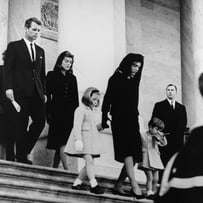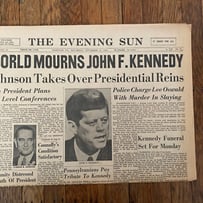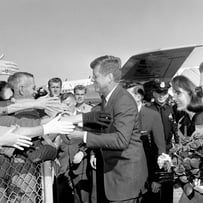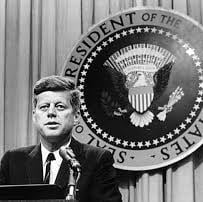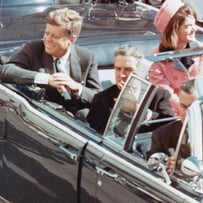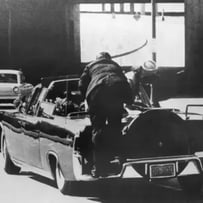A Nation Mourns: The Assassination of President John F. Kennedy
November 22, 1963 – A Tragic Day That Shook the World
WORLDGOAT NEWS
Hindvarta Desk
6/9/20254 min read


Dallas, Texas – November 22, 1963
The world stood in stunned silence. On a clear autumn afternoon, the 35th President of the United States, John Fitzgerald Kennedy, was shot and killed while riding in a motorcade through Dealey Plaza in Dallas, Texas.
The news spread rapidly through television, radio, and newspapers—bringing a wave of shock, disbelief, and mourning to America and across the globe.
At 12:30 PM Central Standard Time, as crowds lined the streets waving American flags and cheering, three shots rang out. Within minutes, the young and charismatic leader who had inspired millions was pronounced dead at Parkland Memorial Hospital.
🇺🇸 A President Full of Promise
John F. Kennedy, born in 1917, had become president at just 43 years old, the youngest elected president in American history. A World War II naval hero, bestselling author, and U.S. Senator from Massachusetts, JFK embodied energy, intellect, and idealism.
His presidency, though short-lived, had already left an indelible mark:
He founded the Peace Corps, inspiring youth to serve humanity across the globe.
He led the U.S. through the Cuban Missile Crisis, narrowly avoiding nuclear war.
He spoke for civil rights, vowing to end racial segregation.
He called for Americans to explore space, declaring the goal of reaching the Moon.
To millions, Kennedy represented hope, modernity, and progress. His sudden death left that hope violently shattered.
The Fatal Motorcade
President Kennedy and First Lady Jacqueline Kennedy had arrived in Dallas as part of a campaign tour ahead of the 1964 re-election bid. Accompanied by Texas Governor John Connally and his wife, the president rode in an open-top limousine to greet the public.
As their car passed the Texas School Book Depository, gunfire erupted. Kennedy was hit twice—once in the upper back and once in the head. Governor Connally was also severely wounded.
Secret Service agents rushed the limousine to Parkland Hospital, but doctors could not save him. At 1:00 PM, Kennedy was declared dead. He was 46 years old.
“The President Is Dead” – A Nation in Shock
Just 38 minutes later, CBS anchor Walter Cronkite, with tears in his eyes, announced to the world:
“From Dallas, Texas, the flash—apparently official: President Kennedy died at 1:00 PM Central Standard Time.”
People wept openly in streets. Schools dismissed early. Churches opened their doors. Businesses closed. The nation plunged into mourning.
In India, Prime Minister Jawaharlal Nehru called it a “deep loss to the civilized world.” Across Europe, Asia, and Africa, flags were flown at half-staff, and tributes poured in for a man many saw as a beacon of peace.
The Accused Gunman: Lee Harvey Oswald
Within hours, police arrested Lee Harvey Oswald, a 24-year-old former U.S. Marine with Marxist sympathies and alleged ties to the Soviet Union and Cuba. He was found hiding in a movie theater and accused of the assassination.
However, before Oswald could be tried, he too was shot and killed—live on national television—by nightclub owner Jack Ruby, just two days after Kennedy's assassination. The dramatic murder of the accused sparked decades of speculation and conspiracy theories.
A Funeral Watched by the World
Kennedy’s body was returned to Washington, D.C., where it lay in state at the Capitol Rotunda. Over 250,000 people waited for hours in cold November air to pay their respects.
On November 25, 1963, his funeral was held at St. Matthew’s Cathedral, attended by global leaders including French President Charles de Gaulle, British Prime Minister Alec Douglas-Home, and Soviet representative Anastas Mikoyan.
Millions watched on television as Jacqueline Kennedy, in a black veil, led a solemn procession behind her husband's casket. The image of John F. Kennedy Jr., only three years old, saluting his father’s coffin became one of the most iconic photographs of the century.
He was laid to rest at Arlington National Cemetery, where an eternal flame still burns at his gravesite.
A Nation Asks Why
In 1964, the Warren Commission concluded that Lee Harvey Oswald acted alone. However, skepticism remained—and still lingers. Questions arose:
Was there a second shooter?
Was the CIA involved?
What about the Mafia, Cubans, or Soviets?
Numerous investigations, including the House Select Committee on Assassinations in 1979, later suggested that Kennedy may have been the victim of a probable conspiracy, though definitive proof remains elusive.
To this day, the Kennedy assassination remains one of the most debated and investigated crimes in history.
A Legacy Cut Short
John F. Kennedy’s assassination was more than the loss of a president—it was the loss of a vision. In his short time in office, JFK had inspired a generation with words like:
“Ask not what your country can do for you—ask what you can do for your country.”
He believed in nuclear disarmament, racial equality, scientific exploration, and global diplomacy. His untimely death left many wondering what could have been—what speeches he would have given, what wars he might have prevented, and how America’s path might have differed.
A Moment Frozen in Time
60 years later, the assassination of John F. Kennedy remains a symbol of national trauma and a pivotal moment in world history. It ushered in an era of cynicism, conflict, and disillusionment—but also reinforced the ideals he stood for.
His brother, Senator Robert F. Kennedy, and son, John F. Kennedy Jr., would also meet tragic ends. But the Kennedy legacy endures.
“A man may die, nations may rise and fall, but an idea lives on.”
— John F. Kennedy
